Angela Hartnett's guide to game: sausage rolls, wild boar pappardelle and more
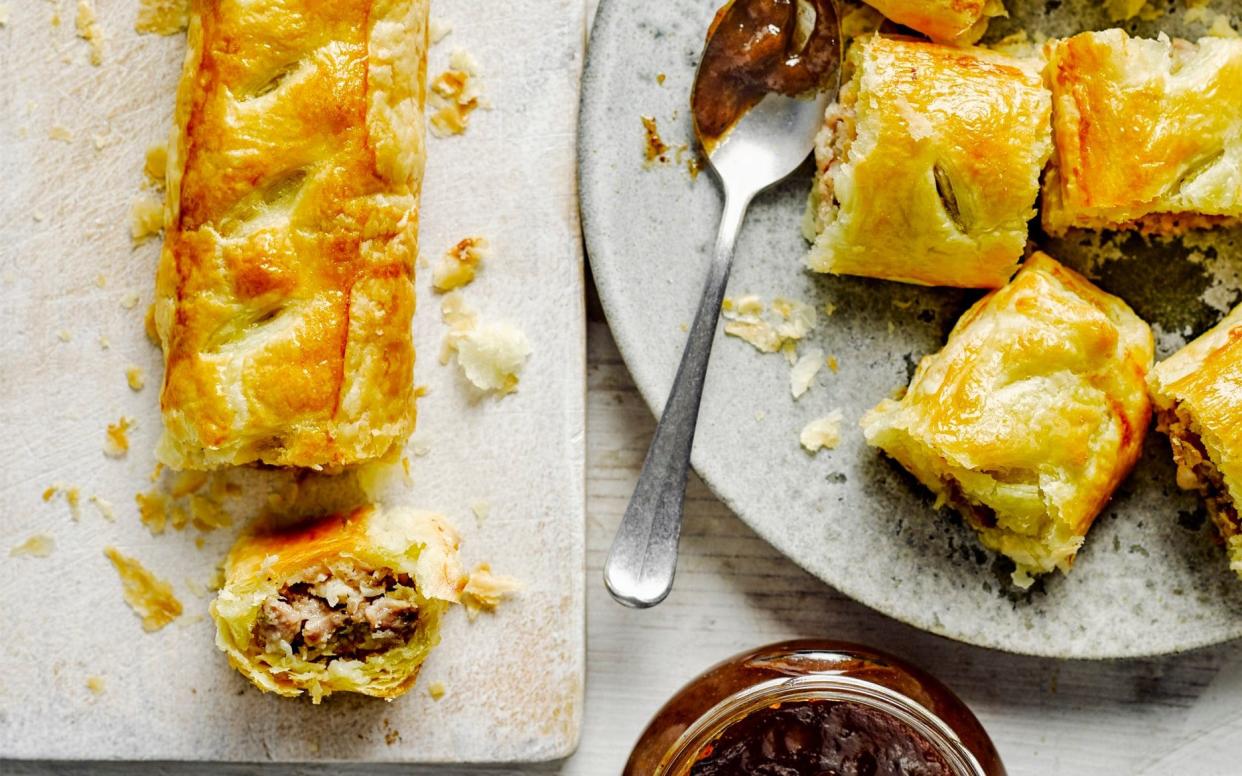
I had never been game shooting before in my life when I joined Richard Bertinet, an amazing baker based in Bath, to have a go. His advice was, “Just don’t point it at anyone – point it upwards and you’ll be fine!”
Fortunately, I managed to enlist someone to give me a more comprehensive lesson. It was a great opportunity to meet up with like-minded people, have fun and eat together. Everyone mucked in, and brought something special along to drink.
Like truffles, game remains truly seasonal, because you can still only get it at certain times of the year (unlike strawberries, or asparagus). I tend to get mine from Braehead Foods in Scotland, but most local butchers should be able to get hold of it for you. H G Walter in Hammersmith is very good; Fortnum’s has a great meat counter, and it’s not ridiculously expensive.
Some people don’t like game to be too “gamy” in flavour, but for me, that defeats the object. If I’m eating game, I want to be able to taste it – otherwise it’s just bland, and a bit pointless. It can be strong – but so can aged beef. Wild boar is a great alternative to pork for a bolognese (the same sort of difference you might expect when you use mutton as opposed to lamb) but for me, even good pork should taste a bit earthy and farmyardy. Although it can be slightly tougher, I prefer wood pigeon to Anjou pigeon – again, because it has a deeper flavour.
Because game is rich, you can be punchier with your seasoning. Venison pairs well with chocolate and chilli, and you can incorporate blackcurrants and redcurrants into your sauces. Don’t be afraid to use spices and marinades: it helps to tenderise the meat. Red wine is the best thing to drink with it. I love simple game stews, hotpots and pies – particularly pithiviers, made with puff pastry.
Be wary of overcooking game, and aim for medium-rare. Tougher cuts warrant braising really slowly, because the muscles have been working a lot harder in the wild than in farm-raised animals. Pan-frying a pheasant just doesn’t work, whereas slow-cooking it in a pot roast will break it down. Don’t go overboard and attempt a venison Wellington if you’ve never cooked venison before – try braising a shoulder of venison in a hotpot instead, to minimise the pressure.
As for the health angle, game is certainly leaner than some other meats, but if I’m absolutely honest I think everything’s fine in moderation. Eat what you like. I’d recommend Hugh Fearnley-Whittingstall’s seminal cookbook, The River Cottage Meat Book, to get you started, and Tom Kitchin, cheffing up in Edinburgh, has released a brilliant book of recipes, Tom Kitchin’s Meat and Game.
Wood pigeon and beetroot salad
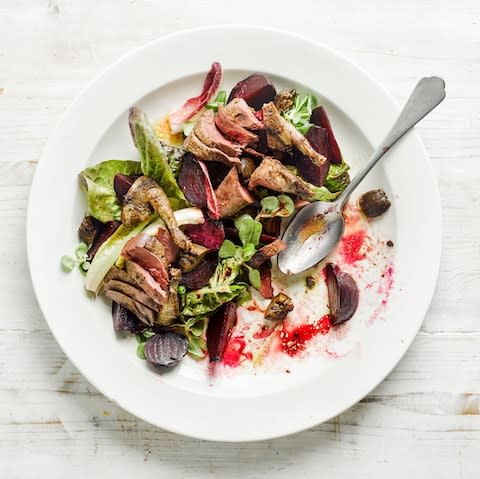
SERVES
Four
INGREDIENTS
500g raw beetroot
2 tbsp brown sugar
Good pinch of rock salt
2 tbsp red wine vinegar
2 sprigs of thyme
Dash of walnut oil
Knob or two of butter
2 wood pigeons, jointed into legs and crown
4 pickled walnuts, chopped
Generous handfuls of winter salad leaves, dressed with a little mustard, oil and vinegar
METHOD
Preheat the oven to 200C/180C fan/Gas 6.
Place a large square of tin foil in a baking tray and place the beetroot in the middle. Scatter with the sugar, salt, vinegar and herbs.
Bring the foil edges together to cover the beetroot loosely. Add a little water to the tray to allow the beetroot to steam.
Place in the oven and cook for 45 minutes to an hour, or until the beetroot is tender. Peel once cool enough to handle. This can be done the night before or a couple of days in advance and left in the fridge.
Turn the oven up to 220C/200C fan/Gas 7.
To cook the pigeon, heat a dash of walnut oil and a knob of butter in an ovenproof pan on the hob, then add the pigeon legs, turning them to colour them all over. Add the crowns, with a bit more butter if necessary, to colour.
Transfer the pan to the oven to cook for seven to 10 minutes until the breast feels slightly firmer and is cooked through. The legs may take longer to cook through than the breasts.
Allow the meat to rest before shredding the leg meat and removing the breasts from the crown. Slice the breasts.
Serve the beetroot sliced or in wedges, topped with salad leaves, pickled walnuts and the leg and breast meat.
Roast mallard with autumn veg
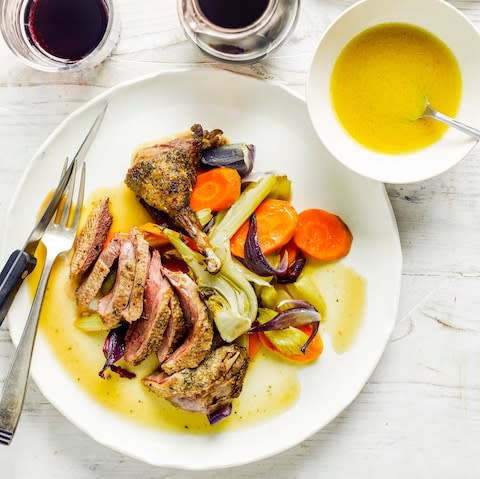
This dish requires some preparation ahead, but once that’s done it’s simple to finish.
SERVES
Four
INGREDIENTS
2 large carrots
4 sticks celery
1 fennel bulb
2 small red onions
6 garlic cloves
Vegetable oil, for cooking
2 sprigs thyme
1 bay leaf
Pinch of cumin seeds, crushed
For the duck
Olive oil, for cooking
2 mallards, plucked, legs removed and reserved (ask a butcher to do this for you if you are unsure)
Juice of 1 orange
200ml chicken stock
1 tsp butter
1 tsp Dijon mustard
½ tsp honey
50ml olive oil
10ml red wine vinegar
METHOD
Preheat the oven to 200C/180C fan/Gas 6.
Prepare your vegetables. Peel the carrots and slice them into large lozenges. Wash the celery sticks and slice into similar length pieces. Strip any discoloured outer layers from the fennel bulb and cut it into wedges, removing a bit of the core but still keeping the wedges intact.
Toss all the vegetables, along with the red onion and garlic, together in a baking tray with a dash of vegetable oil and the herbs, and sprinkle over the crushed cumin seeds. Season well.
Pour in 100ml of water and cook in the oven for about 30 minutes, or until the vegetables are soft. Check the tray every so often to make sure the vegetables are not drying out (sprinkle in some water if so). Remove from the oven and set aside.
Meanwhile, start to braise the duck legs. These will always be tougher to eat, so need a longer cooking time.
Heat a touch of oil in an ovenproof pan over a high heat. Season the legs all over, then add them to the pan and cook them briefly to colour all over.
Set the legs skin-side down in the pan. Add the orange juice to deglaze (scraping the pan with a wooden spoon to dislodge any tasty bits), then add the chicken stock and cover the legs with parchment paper.
Place the legs in the oven and cook until you are able to bend them easily – about 20 minutes.
Pat dry the two mallards with kitchen paper and season well inside and out. Cook in a large oiled ovenproof pan over a high heat to add some colour to both sides – no more than two to three minutes. Add the butter to the pan and baste the breasts with any juices, then place in the oven for eight minutes depending on the size, until cooked through.
Remove from the oven and allow to rest for 10 minutes before carving.
To finish the dish, lightly reheat the vegetables and distribute between the plates. Add the duck legs (keeping the braising liquid), and slice the duck breasts and add to the plates.
Heat the duck braising liquid, stir in the mustard, honey, olive oil and vinegar, and mix well. Pour this all over the duck and serve.
Game and sausage rolls with brown sauce
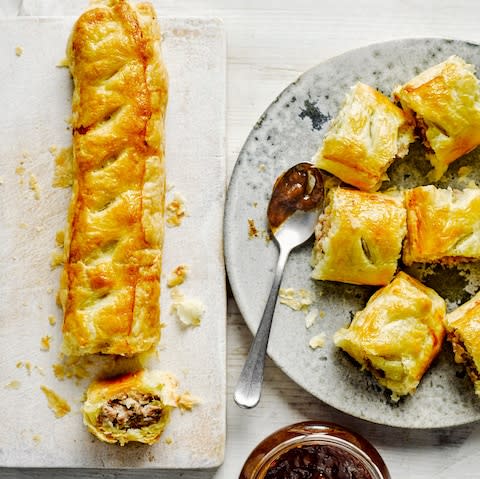
MAKES
Two large rolls
INGREDIENTS
For the brown sauce (this makes about 250ml)
450g cooking apples, peeled, cored and roughly chopped
115g prunes
1 small onion, finely chopped
125ml red wine vinegar, or as needed
½ tbsp ground ginger
½ tsp ground nutmeg
½ tsp allspice
½ tsp cayenne
2 tsp salt
225g sugar
50ml water
For the game and sausage rolls
Oil, for cooking
1 small onion, finely chopped
1 garlic clove, chopped
1 juniper berry, crushed
125g good-quality sausage meat
125g minced game meat
½ tsp chopped rosemary
Flour, for dusting
250g puff pastry or quick flaky pastry
1 egg, beaten
METHOD
To make the sauce, add everything to a large pan. Cook over a low heat until the fruit is soft and has broken down to a thick consistency. Transfer to a blender and blitz until smooth, then check the flavour and add more vinegar if necessary. Store in jars or bottles in the fridge.
For the rolls, add a dash of oil to a frying pan and cook the onion and garlic with the juniper until the onion is soft but not coloured. Remove from the heat and allow to cool.
Crumble the sausage and game meat into a bowl and add the cooled onion, mixing it well and seasoning with salt, pepper and the chopped rosemary.
Take a teaspoonful of the mixture and pat it into a mini burger, then fry this until cooked to taste, to test the seasoning. Adjust the raw mixture if necessary.
Mould the raw mixture into two long logs about 33cm long and 3cm wide (a little flour on your hands can help if the mixture is very sticky). Set the logs on a tray in the fridge.
When ready to cook, preheat the oven to 220C/200C fan/Gas 7. Roll out the pastry on a lightly floured surface to make two oblongs, each approximately 12 x 35cm.
Place one meat log on top of each pastry piece and bring the pastry together to seal, using a little water to dampen the pastry sides. Turn each roll over so the seal is underneath.
Place both sausage rolls on a lined baking sheet and glaze them with the beaten egg. Score diagonally along the rolls with a knife.
Cook for 20-25 minutes until a nice golden brown. Allow to cool slightly, then cut with a bread knife and serve hot with the brown sauce.
Wild boar pappardelle
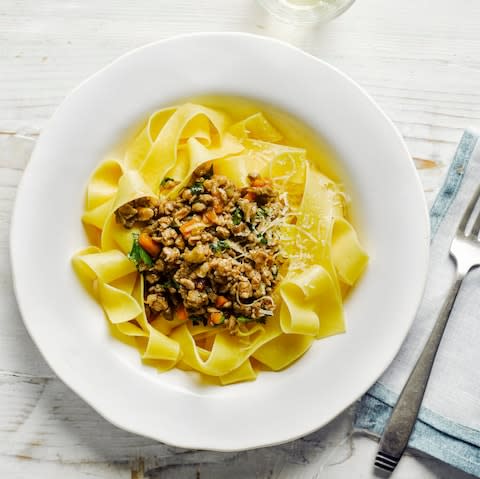
Lots of wild boar comes from Europe but you can look out for it from Scottish meat suppliers. You can easily replace it here with venison, too.
SERVES
Four
INGREDIENTS
Oil, for cooking
300g mixed roughly chopped carrot, onion and celery
2 garlic cloves, finely chopped
500g wild boar meat, minced or finely chopped
1 tsp tomato purée
100ml red wine
200ml chicken stock
1 bay leaf
To serve
Freshly cooked pappardelle
Chopped parsley
Freshly grated Parmesan
METHOD
Using a pan large enough to hold all the ingredients, start by heating three tablespoons of oil and add the chopped vegetables and garlic. Sauté until the vegetables are soft but haven’t taken on any colour.
Add the meat and sauté briefly just until it loses its redness – it does not need to be cooked through.
Add the tomato purée and cook for four minutes, then add the wine and reduce the liquid to a glaze before adding the stock, bay leaf and enough water to cover. Put the lid on and cook for a couple of hours, checking every once in a while to stir, until the meat is coated in a nice thick sauce.
The sauce can be stored in the fridge for a couple of days, or served on the day with fresh pappardelle. Finish with chopped parsley and freshly grated Parmesan.

